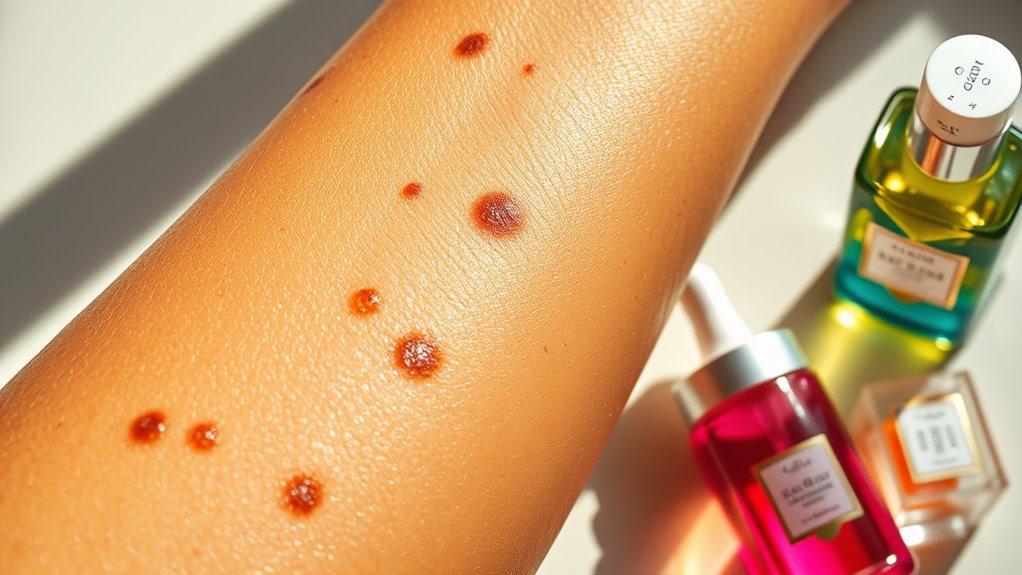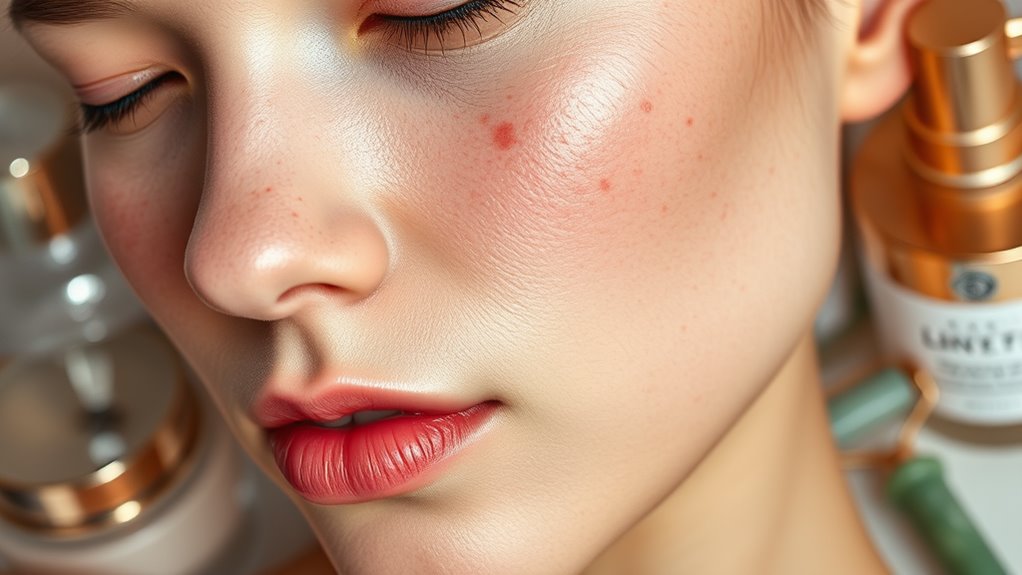Why Dark Spots Take Forever to Fade – and How to Speed It Up
Dark spots can take a long time to fade due to excess melanin production, skin type, and ongoing sun exposure. Your skin’s turnover rate and the presence of underlying factors, like hormonal changes, also influence persistence. To speed up fading, consistently use treatments with ingredients like vitamin C, retinoids, and broad-spectrum sunscreen. Staying hydrated and maintaining a nutrient-rich diet supports skin health. Learn how to enhance your skincare routine and prevent new spots from forming.
Key Takeaways
- Dark spots persist due to factors like hormonal fluctuations, skin type, and genetics affecting melanin production and cell turnover rates.
- Sun exposure exacerbates pigmentation, making it crucial to use broad-spectrum sunscreen and limit direct sunlight.
- Consistent application of targeted treatments, such as retinoids and vitamin C, can enhance fading by promoting cell turnover and inhibiting melanin production.
- Maintaining a proper skincare routine and lifestyle, including hydration and a nutrient-rich diet, supports skin health and speeds up fading.
- Professional treatments like chemical peels or laser therapy can provide faster results by effectively targeting deeper pigmentation issues.
Understanding Dark Spots: Causes and Types
Dark spots, also known as hyperpigmentation, occur when excess melanin forms in specific areas of the skin. Several factors contribute to this condition, including sun exposure, hormonal changes, and skin injuries.
Sun-induced hyperpigmentation, or solar lentigines, often appears on areas frequently exposed to sunlight. Additionally, post-inflammatory hyperpigmentation arises after skin trauma, such as acne or cuts.
Understanding the types of dark spots is crucial for selecting the right treatment to fade dark spots faster. Chemical exfoliants, such as alpha hydroxy acids (AHAs) and beta hydroxy acids (BHAs), can accelerate skin cell turnover.
Furthermore, incorporating antioxidants like vitamin C into your routine can help inhibit melanin production, leading to a more even skin tone over time. Regular use of effective treatments can significantly enhance the fading process of dark spots.
The Role of Melanin in Skin Discoloration
Melanin plays a crucial role in skin discoloration, as it is the pigment responsible for the color of your skin, hair, and eyes. It’s produced by melanocytes in response to UV exposure, inflammation, or hormonal changes. When melanin production goes awry, you might notice dark spots. Understanding different types of melanin can clarify why some areas of your skin appear discolored. Additionally, factors such as sun exposure can significantly increase melanin production, leading to more pronounced dark spots.
| Type of Melanin | Description |
|---|---|
| Eumelanin | Dark brown to black pigment |
| Pheomelanin | Yellow to red pigment |
| Distribution | Varies by skin type and exposure |
| Function | Protects against UV radiation |
Why Some Dark Spots Are More Persistent
Some dark spots cling to your skin longer due to hormonal influences that can increase melanin production. Additionally, variations in skin type—such as oiliness or sensitivity—can affect how your skin responds to treatments. Understanding these factors is crucial for effectively addressing persistent pigmentation issues. Furthermore, improper sun protection can lead to exacerbated dark spots, making it essential to incorporate effective strategies for prevention and treatment.
Hormonal Influences on Pigmentation
As hormonal fluctuations occur throughout your life, they can significantly impact skin pigmentation, leading to more persistent dark spots. Changes in hormone levels, particularly estrogen and progesterone, can trigger melanin production, causing hyperpigmentation. This often results in dark spots that resist fading.
To better understand these hormonal influences, consider the following:
-
Menstrual Cycle: Fluctuating hormones during your cycle can worsen pigmentation, especially premenstrually.
-
Pregnancy: Elevated hormone levels can lead to melasma, a condition characterized by dark patches on the face.
-
Hormone Replacement Therapy: This can also exacerbate pigmentation changes, particularly in menopausal women.
Skin Type Variability Effects
While factors like sun exposure and hormonal changes play significant roles in skin pigmentation, your skin type can also determine how quickly dark spots fade.
Individuals with oily skin often experience a slower fading process due to increased sebum production, which can lead to clogged pores and prolonged inflammation.
Conversely, those with dry skin may notice dark spots fading faster, as their skin tends to regenerate more efficiently.
Additionally, people with deeper skin tones may struggle more with persistent pigmentation due to the increased melanin levels, making hyperpigmentation more pronounced.
Understanding your skin type enables you to tailor treatments effectively, optimizing your approach to fading dark spots.
This strategic personalization can significantly expedite your desired results.
The Impact of Sun Exposure on Dark Spots
Sun exposure significantly affects the development of dark spots on your skin due to UV rays triggering hyperpigmentation.
Over time, this exposure can lead to long-term skin damage, exacerbating existing spots and creating new ones.
Understanding prevention strategies is crucial to minimize the impact of sunlight on your skin and maintain an even complexion. Additionally, applying sunscreen daily is essential in protecting your skin from harmful UV rays and preventing further dark spot formation.
UV Rays and Hyperpigmentation
Exposure to UV rays significantly contributes to the development of hyperpigmentation, a condition characterized by dark spots on the skin.
When your skin is exposed to UV radiation, it stimulates melanocyte activity, leading to increased melanin production. This process results in uneven pigmentation and dark spots, particularly in sun-exposed areas.
To mitigate the impact of UV rays on hyperpigmentation, consider the following:
- Use broad-spectrum sunscreen**** daily, even on cloudy days, to protect against UVA and UVB rays.
- Seek shade during peak sun hours (10 a.m. to 4 p.m.) to minimize direct exposure.
- Incorporate antioxidants into your skincare routine to combat oxidative stress caused by UV exposure.
Long-Term Skin Damage
Prolonged exposure to UV radiation doesn’t just cause immediate effects; it leads to long-term skin damage that exacerbates dark spots.
UV rays penetrate the skin, damaging the DNA in skin cells and triggering an inflammatory response. This process stimulates melanocyte activity, increasing melanin production, which manifests as dark spots over time.
Additionally, chronic UV exposure depletes collagen and elastin, compromising skin elasticity and promoting uneven skin tone. The cumulative effects can result in photoaging, further intensifying pigmentation irregularities.
As you age, the skin’s ability to heal diminishes, making these dark spots more persistent. Understanding this relationship between sun exposure and skin health is crucial for developing effective treatment strategies to address and mitigate dark spots, enhancing your skin’s overall appearance.
Prevention Strategies for Sunspots
While enjoying the outdoors is essential for overall well-being, it’s crucial to adopt effective prevention strategies to minimize the risk of developing sunspots.
Prolonged sun exposure can lead to hyperpigmentation, so consider these strategies:
-
Use Broad-Spectrum Sunscreen****: Apply a broad-spectrum SPF 30 or higher every two hours, even on cloudy days.
-
Wear Protective Clothing****: Opt for long sleeves, wide-brimmed hats, and UV-blocking sunglasses to shield your skin.
-
Seek Shade: Whenever possible, stay in the shade during peak sun hours (10 a.m. to 4 p.m.) to reduce direct exposure.
The Healing Process of the Skin
As your skin undergoes the healing process, it activates a complex series of biological responses designed to repair damaged tissues and restore its natural barrier.
Initially, inflammation occurs, bringing immune cells to the site of injury to combat pathogens and clear debris. This is followed by the proliferation phase, where fibroblasts generate collagen and elastin, essential for skin strength and elasticity.
As new cells migrate to the surface, the epidermis begins to regenerate, promoting healing and reducing the visibility of dark spots.
Over time, the final remodeling phase reshapes collagen fibers, enhancing skin texture. Additionally, maintaining a healthy skin barrier is crucial during this process to prevent further damage and support overall skin health.
Understanding this intricate process empowers you to support your skin’s recovery, ensuring optimal conditions for fading dark spots and achieving a healthier complexion.
Factors That Influence Dark Spot Fading
Several key factors influence how quickly and effectively dark spots fade, and understanding these can help you optimize your skincare routine.
Here are three critical elements to consider:
-
Sun Exposure: UV rays can worsen pigmentation. Limiting sun exposure and using sunscreen prevents further darkening, enhancing fading.
-
Skin Type and Tone: Your skin’s response to treatments varies. Dark spots on lighter skin often fade faster than those on deeper skin tones due to melanin distribution.
-
Cell Turnover Rate: Your skin’s natural exfoliation process affects fading. Higher turnover rates, influenced by age and skin health, can accelerate the fading of dark spots.
Topical Treatments for Dark Spots
When considering how to effectively fade dark spots, topical treatments play a crucial role in your skincare arsenal. Ingredients like hydroquinone, a potent skin-lightening agent, inhibit melanin production, leading to a noticeable reduction in pigmentation.
Retinoids, derived from vitamin A, stimulate cell turnover, promoting the shedding of pigmented skin cells. Vitamin C, a powerful antioxidant, brightens the skin and protects it from oxidative stress.
Alpha hydroxy acids (AHAs) exfoliate the outer skin layer, enhancing the absorption of other treatments while revealing fresher skin beneath. Niacinamide, on the other hand, reduces inflammation and regulates melanin transfer.
When selecting a topical treatment, ensure it contains clinically validated ingredients tailored to your specific skin type and concerns for optimal results.
The Importance of Consistency in Skincare
While you may be eager to see quick results from your skincare routine, consistency is key to effectively fading dark spots. Regular application of targeted treatments allows active ingredients to penetrate the skin and promote cellular turnover, which is essential for reducing pigmentation.
Here are three reasons to maintain consistent skincare:
-
Enhanced Efficacy: Ingredients like vitamin C and retinoids work best with prolonged use, maximizing their impact on melanin production.
-
Skin Adaptation: Your skin needs time to adapt to new products, minimizing irritation and optimizing absorption.
-
Long-term Results: Consistency fosters cumulative effects, gradually diminishing dark spots and preventing their return.
Stick to your routine, and you’ll achieve the mastery you seek in skincare.
Professional Treatments to Consider
If you’re looking to accelerate the fading of dark spots, professional treatments can offer more immediate and potent results compared to over-the-counter options.
Dermatologists often recommend chemical peels, which utilize acids to exfoliate the skin, promoting cellular turnover and reducing pigmentation.
Laser treatments, such as fractional laser therapy, target melanin directly, breaking it down while stimulating collagen production.
Intense pulsed light (IPL) therapy also effectively diminishes discoloration by targeting specific wavelengths to penetrate the skin.
Additionally, prescription-strength topical agents like hydroquinone or retinoids can enhance the effects of these treatments.
Consulting a qualified dermatologist will ensure you choose the best approach tailored to your skin type and dark spot severity, maximizing efficacy and minimizing potential side effects.
Lifestyle Changes to Support Skin Health
To effectively support your skin health, you need to focus on key lifestyle changes.
Prioritizing hydration, consuming a nutrient-rich diet, and practicing diligent sun protection can significantly enhance your skin’s resilience and appearance.
These adjustments not only help fade dark spots but also promote overall skin vitality.
Hydration and Skin Health
Hydration plays a crucial role in maintaining skin health, as it directly affects the skin’s ability to repair and regenerate itself.
When your skin is well-hydrated, it can better fend off external aggressors and recover from damage.
To enhance your skin’s hydration levels, consider these three strategies:
-
Drink Water: Aim for at least 8 glasses daily. Proper internal hydration helps maintain skin elasticity and reduces dryness.
-
Use Humidifiers****: Adding moisture to the air, especially in dry environments, can prevent transepidermal water loss.
-
Topical Moisturizers: Choose products with hyaluronic acid or glycerin, which attract and retain moisture in the skin.
Implementing these practices can significantly improve your skin’s hydration, supporting its overall health and appearance.
Nutrient-Rich Diet Choices
Maintaining well-hydrated skin is just one piece of the puzzle when it comes to achieving a radiant complexion and fading dark spots. A nutrient-rich diet plays a crucial role in skin health.
Incorporate antioxidants like vitamins C and E, found in citrus fruits and nuts, to combat oxidative stress that can exacerbate pigmentation. Omega-3 fatty acids, present in fatty fish and flaxseeds, help maintain skin barrier function and reduce inflammation.
Additionally, zinc, abundant in legumes and whole grains, supports skin repair and regeneration. Staying consistent with these nutrient-dense foods not only enhances your skin’s resilience but also accelerates the fading of dark spots.
Prioritize a balanced diet to empower your skin’s natural healing processes effectively.
Sun Protection Practices
While you may focus on skincare products to address dark spots, sun protection practices are equally essential for promoting skin health.
Effective sun protection not only prevents further pigmentation but also supports the fading of existing spots. Here are three key practices to integrate into your routine:
-
Use Broad-Spectrum Sunscreen*: Apply a *high-SPF, broad-spectrum sunscreen daily, even on cloudy days, to shield your skin from UVA and UVB rays.
-
Reapply Regularly: Reapply sunscreen every two hours, or more frequently if swimming or sweating, to maintain optimal protection.
-
Seek Shade: Limit sun exposure, especially between 10 AM and 4 PM when UV rays are strongest, to reduce the risk of exacerbating dark spots.
Implementing these practices is vital for achieving and maintaining even-toned skin.
Preventing New Dark Spots From Forming
To effectively prevent new dark spots from forming, you must prioritize sun protection as a key strategy. Daily application of a broad-spectrum sunscreen with at least SPF 30 is essential, regardless of weather conditions.
Additionally, wearing protective clothing and seeking shade during peak sun hours can significantly reduce UV exposure.
Beyond sun protection, consider incorporating antioxidants like vitamin C into your skincare routine, as they can counteract oxidative stress and enhance skin resilience.
Regular exfoliation, using products with alpha hydroxy acids or retinoids, can promote cell turnover, minimizing the likelihood of hyperpigmentation.
Lastly, be mindful of hormonal changes or skin irritations that can trigger dark spots; addressing these proactively is crucial for maintaining an even complexion.
Patience: The Key to Fading Dark Spots
Patience plays a crucial role in the journey of fading dark spots. Understanding that skin regeneration requires time can help you manage expectations and stay committed to your regimen.
Here are three key principles to remember:
-
Consistency is Essential: Regular application of targeted treatments ensures that active ingredients effectively penetrate the skin, promoting cellular turnover.
-
Skin Cycle Awareness: The average skin cell turnover rate is about 28 days. Recognize that visible results may take several cycles to manifest.
-
Avoid Over-Treatment: Resist the urge to excessively exfoliate or apply multiple products simultaneously, as this can irritate your skin and hinder progress.
Embrace the process, and with time, your diligence will yield the clarity and radiance you seek.




